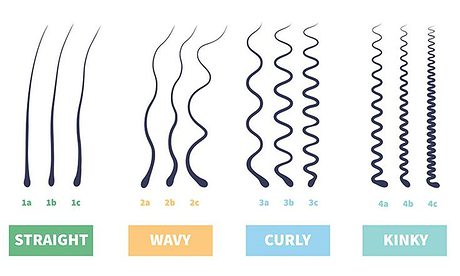Determining your hair type is essential to decide on the best ways to style and care for it; there are four primary hair types: straight, Wavy, Curly, and Coily. For each category, there are three subcategories according to curl patterns and thicknesses; what works and is suitable for one hair texture ( type ) is different for another, some products should be avoided, and others are essential. Are you ready to come on a hair care journey with us? To ensure your hair is strong, nourished, and looking its best, keep reading to learn everything you need to know about hair types.
Types of Hair
You can, from first sight, determine if the hair is straight or curly, but it’s not simply like that. Did you know that there are 12 types of hair? There are several subcategories for each hair texture, helping you identify your hair type and how to care for it and style it; there are four main types, and each category has three subcategories.
Type 1: Straight
Type 2: Wavy
Type 3: Curly
Type 4: Coils/Kinky
-
straight type
Lies flat on the scalp and has no curls patterns but is classified according to the thickness of hair into three category
- Type 1A: Straight hair that is fine & thin. No curl or wave pattern. There is little volume, so it is challenging to style it to a curly hairstyle if you want.
- Type 1B: Medium thickness & has some volume.
- Type 1C: Coarse and thick and can be styled to create curls or waves because it has more hold. also has some volume. This hair texture can be prone to frizz.
Straight hair is easy to brush and often appears glossy and healthy-looking, but it tends to become oily, so it is recommended that you check the label of the product to avoid adding extra oil to your hair.
Wash your hair too much causes the scalp to overproduce oils, so to solve this problem, wash your hair with dry shampoo or avoid washing the hair too often.
-
Wavy Hair
It is defined by an S shape. It is one of the most sought-after hair textures because it creates a gorgeous, tousled appearance that can soften the features and be styled in various ways. They are categorized according to the degree of the wave, from undefined waves to waves with a more defined shape.
- Type 2A: Wavy and fine .
- Type 2B: Wavy with a slightly more defined S-shape, This hair texture can be prone to frizziness.
- Type 2C: Wavy with well-defined S-shaped waves and fuller and thicker.
TIPS: To avoid flattening out that wave avoid oil-based products and creams, instead recommend that you boost with light mousse or use gel to define those waves .
-
Curly Hairs
It is defined as hair that has spiral curls. There are three subcategories of curly hair with varying thicknesses and curls appearing loose or tight.
- Type 3A: Loose curls.
- Type 3B: Tight and springy curls.
- Type 3C: An S or Z shape that springs back into shape when stretched.
Tips: can be prone to dryness and frizz and challenging to care for. You want to take care to keep the hair’s natural moisture intact, which can be done with the right shampoos and leave-in conditioners; they should be free from sulfates and silicone. Also you want to minimize heat styling.
-
Coils/Kinky
Coils have well-defined tight curls or ringlets that are voluminous and full of movement. It is also referred to as Afro-textured hair. The texture appears thick and complete but is prone to dryness and frizz; care needs to be taken when styling it. This hair type needs a lot of moisture and can easily break or be damaged.
- Type 4A: Loose coils.
- Type 4B: Zig-zagging coils.
- Type 4C: Tight coils.
Hair Types FAQ
2. Can hair type change with age?
As you age, your hair texture will most likely change. It may appear more gray and less voluminous, and your hair density may also decrease.

